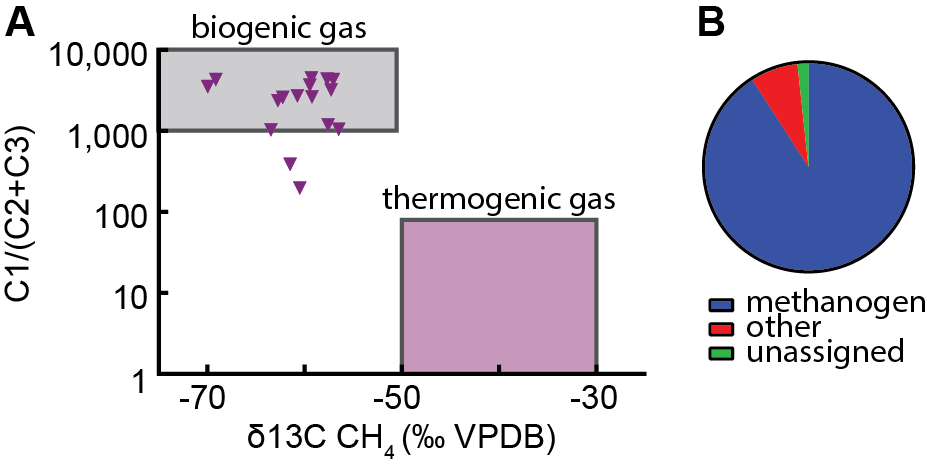Reports: UNI253188-UNI2: Field Study of Fundamental Controls on Methane Formation in a Coalbed Methane Reservoir
Matthew F. Kirk, PhD, Kansas State University
Our research group has made considerable progress toward developing an understanding the two-way interactions between geochemistry and microbiology in coalbed methane reservoirs in the Cherokee Basin, Kansas, USA. Our efforts during project year 1 include:
1. Field work. During August, 2013, we began working with employees of an energy company to identify fifteen commercial coalbed methane wells for sampling. The wells we selected span most of the area of current coalbed methane production in Cherokee Basin. We had originally planned to also include wells from the Forest City Basin. However, no energy producers are currently active there so our efforts were restricted to the Cherokee Basin. During a single field trip in November, we successfully sampled each of the wells we identified (Fig. 1). Our efforts in the field included collection of water, gas, and microbe samples as well as several measurements.
Figure 1. Location of fifteen commercial gas wells sampled for the study.
2. Geochemical and microbiological characterizations. In the months that followed our field trip, we have completed a wide range of analyses. We used ion chromatography, spectrophotometry, and titrations to analyze the bulk chemical composition of our water samples. We arranged for chemical and isotopic analyses of gas samples. We characterized microbial community composition by extracting total community DNA from microbe samples, obtaining a sequencing analysis, and processing our sequence data. Lastly, we also carried out a culturing analysis to evaluate whether viable cells were present in our samples.
3. Preliminary findings. Our results shed light on the origin of natural gas in Cherokee Basin coalbeds, variation in gas and water geochemistry across the basin, and geochemical controls on microbial methane formation. The salinity of formation water samples increased with distance west across the field area, paralleling the trend in coal depth. Our gas geochemical and microbiological analyses demonstrate that gas we sampled is primarily biological in origin (Fig. 2) and that viable methanogenic microorganisms remain present. Statistical analyses comparing microbial community data to basin geochemistry show that salinity is a major control on microbial community composition and thereby methane formation.
Figure 2. Geochemical and microbiological results demonstrating that natural gas we sampled formed biologically. (A) Variation in the carbon isotopic composition of methane relative to the gas dryness index (the ratio of methane (C1) to the sum of ethane (C2) and propane (C3)). Values for our samples plot with the range of values that typically characterize biogenic gas. (B) Pie chart depicting the dominance of sequences classified within groups of methanogens in our analysis of archaeal sequences.
4. Professional development. This funding has provided an invaluable early boost to my research program! I have used my award to fund my first graduate and undergraduate students, established a working relationship with an energy industry partner, and collect a dataset that will provide a strong foundation for future energy research. The graduate student involved in the project gained experience writing a small student research proposal, which was funded and has allowed us to expand our analytical efforts. The primary undergraduate student involved in the study has gained broad research experience that will improve the competitiveness of his graduate applications this winter. A second undergraduate student became involved in the study by successfully obtaining a university undergraduate research award. During the initial year of the project, we have presented our preliminary findings at local and national conferences including an invited presentation at the Goldschmidt annual meeting (Sacramento, 2014), the K-State Research Forum, and the K-State Department of Geology Alumni Council meeting. We are currently working to complete manuscripts describing our study, which provides addition training for the students.













